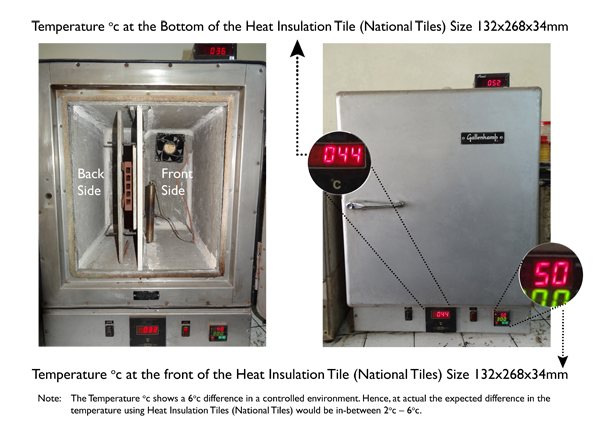Heat Resistance
National Tiles has developed Insulation Tiles for Roof & Terraces with Special Heat Reflective glaze (HRNT-613), which contributes to energy saving by decreasing cooling & heating cost.
National Insulation Tiles are also available in 10mm HRNT-613 (N) thickness which insulate 30% less insulation compared to 34mm cavity Tiles.
Now you can have the advantage of National Insulation Tiles for the insulation from heat/ Cold/ Frost proofing of roofs of residential projects, industrial projects, commercial buildings and storage facilities.
 |
Heat radiation through the roof
Radiation from the sun can increase the temperature on a flat roof surface very high. The heat penetrates via the top layer to the inside, resulting in temperatures in the underlying building and/or level increasing to extreme heights (figure 1a).
By installing National Insulation Tiles on top of the existing roof, the sun’s radiation can no longer reach the underlying roof and thus prevents it from warming up. (Figure 1b) The inside temperature will be reduced, which provides a more pleasant and comfortable work environment.

Low temperatures
National Insulation Tiles provide extra energy savings during cold periods too. During colder periods with frost over the roof tiles, a clear difference in temperature is noticeable. Measuring Results of January 2010 (frost) on the bare roof shows low (-) temperatures, while at the same time under the National Tiles they show warmer temperature. Snow is also prevented from making direct contact with the Insulation material, resulting in the formation of an insulating blanket above the cavity layer and creating a layer of still air that provides extra insulation (figure4a&4b).

Advantages:
CSR (Corporate Social Responsibility):
This attaches great importance to the criteria set by the government on CSR (Corporate Social Responsibility). With the large savings made by National Insulation Tiles in both energy and raw materials, greenhouse gas emissions and its own purchasing and production policies, this lines up perfectly with the criteria for CSR (Corporate Social Responsibility) as drawn up by most other countries.
Environmentally-friendly approach:
An environmentally-friendly approach is essential for the economy. All the waste from the manufacturing process is recycle and reused in the production. This involves non-fired tiles rejected throughout the manufacturing process, or tiles found defective after the firing phase. All waste water is filtered using a special technological procedure and re-used together with the filtered solid particles in the manufacturing process. The manufacturing process only uses natural materials without the content of heavy metals. Generally, it is a waste-less technology.
A summary of the benefits:
- Using top of the line state-of-the-art technology.
- Can be used on many roofs without any necessary adjustments by just using cement.
- The roof can be utilized for conducting any event, as the roof looks neat and tidy and can take movable weight.
- Extends the life of the underlying roof. In case of bitumen the life can even be expanded by 2 to 4 times (depending on the type of bitumen)
- Prevents odor of bitumen
- High foot traffic is possible
- Long term high insulation efficiency.
- Excellent compressive strength.
- Anti-slip
- No maintenance
- Storm-proof
- Large energy savings to be achieved and thus CO2 reduction and financial benefits
- Comfortable living / working climate
- Decrease of needed cooling power
- Uniform density distribution.
- Resistance to aging and rotting
- High resistance to thermal cycle.
- Temperature difference indoors can reduce
- Large savings on staff downtime and productivity
- User-friendly (You can use the roof for work space or organizing any event)
- Aesthetically pleasing
- UV and infrared resistant
- Investment in the future
- You show corporate social responsibility
- Thoroughly closed-cell structure.
Usage:
- Roof Insulation of Residential complexes (Apartments, Bungalows etc.)
- Roof Insulation of Pharmaceuticals Factories
- Roof Insulation of Commercial & Industrial buildings
- Roof Insulation of Cold Storages (Perishable items)
- Roof Insulation of Poultry Farms, Meat Farms etc.
- Roof Insulation of Water Tank, Acid Tanks etc.
Reflection provides a high albedo (extent of reflection of light.):
The HRNT613 glaze provides high reflection of the sun’s radiation (85%) resulting in the ambient temperature being significantly reduced. Keeping this in mind, the National Insulation Tiles can be used as an effective measure against Urban Heat Island Effect (UHI). Also, smog and particulates in industrial development and / or urban areas are contained. This special reflective glaze is used on 2 thicknesses tiles. The two options in thicknesses are available to cater the price sensitive clients as well.
HRNT613 thickness options for Heat Insulation Tiles:
- HRNT 613 (I) 34 mm (Insulation Tiles)
- HRNT 613 (N) 10 mm (Non Cavity Tiles - will achieve about 30 to 35% of the result and saves cost)
No. |
Sizes/Type |
HRNT613 (N)132x268mm |
HRNT613 (I)132x268mm |
1 |
Thickness (mm) Approx |
10mm |
34mm |
2 |
Weight Per Box. (KG) Approx |
11 KG |
10 KG |
3 |
No. of Tiles per Box |
14 |
5 |
4 |
Sq. Mtr. Per Box |
0. 50 Sq. Mtr |
0. 20 Sq. Mtr |
5 |
No. of Boxes per Sq. Mtr |
2 |
5 |
6 |
Sq. Mtr per 20 Feet Container |
800 |
300 |
| COMPARE DIFFERENT TYPES OF ROOF WHEN TEMPERATURE IS 40 DEGREE CELSIUS. IN BETWEEN 12 NOON TO 4PM | |||
DIFFERENT TYPES OF ROOF |
LASER SOPT TEMPERATURE.ROOF FLOOR OUTSIDE |
LASER SPOT |
INSIDE ROOM TEMPERATURE |
NORMAL CONCRETE ROOF |
55 DEGREE CELSIUS |
39 DEGREE CELSUIS |
37 DEGREE CELSIUS |
BITUMINOUS SURFACE ROOF |
65 DEGREE CELSIUS |
42 DEGREE CELSIUS |
40 DEGREE CELSIUS |
National Tiles HRNT 613 (I) 34mmUsed AREA.INSIDE TEMPERATURE |
50 DEGREE CELSIUS |
38 DEGREE CELSIUS |
34 DEGREE CELSIUS |


Kindly note the laying procedure for installing the HRNT (I) 613:
1- Laying of the HRNT (I) 613 can be done with SR Cement or Normal Cement or Bond.
2- A 10mm grove has to be maintained in between all the tiles.
3- Any pattern could be followed.
4- The grouting has to be done after two days of the completion of the tiles installed with water quiring on both days.
5- The grout will consist of 2 steps: (a) You would require 10 mm thick Styrofoam, which will be of exact 24mm of height from the base of the installed tiles. (b) the upper layer of 10mm will be covered by the normal grouting material or Cement.


